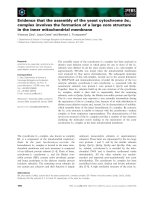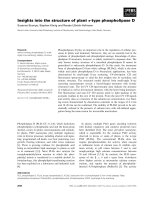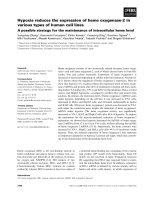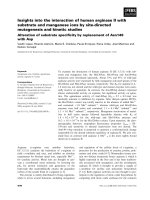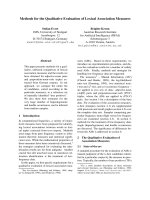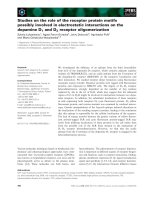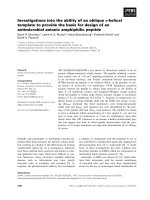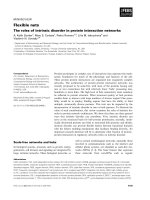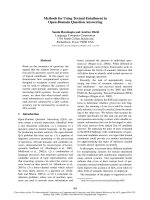báo cáo khoa học: " Methods for the de-identification of electronic health records for genomic research" ppsx
Bạn đang xem bản rút gọn của tài liệu. Xem và tải ngay bản đầy đủ của tài liệu tại đây (315.18 KB, 9 trang )
Electronic health records and the need for
de-identication
Electronic health records (EHRs) are increasingly being
used as a source of clinically relevant patient data for
research [1,2], including genome-wide association studies
[3]. Often, research ethics boards will not allow data
custodians to disclose identifiable health information
without patient consent. However, obtaining consent can
be challenging and there have been major concerns about
the negative impact of obtaining patient consent on the
ability to conduct research [4]. Such concerns are re-
inforced by the compelling evidence that requiring
explicit consent for participation in different forms of
health research can have a negative impact on the process
and outcomes of the research itself [5-7]. For example,
recruitment rates decline significantly when individuals
are asked to consent; those who consent tend to be
different from those who decline consent on a number of
important demographic and socio-economic variables,
hence potentially introducing bias in the results [8]; and
consent requirements increase the cost of, and time for,
conducting the research. Furthermore, often it is not
practical to obtain individual patient consent because of
the very large populations involved, the lack of a relation-
ship between the researchers and the patients, and the
time elapsed between data collection and the research
study.
One approach to facilitate the disclosure of information
for the purposes of genomic research, and to alleviate
some of the problems documented above, is to de-
identify data before disclosure to researchers or at the
earliest opportunity afterwards [9,10]. Many research
ethics boards will waive the consent requirement if the
first ‘use’ of the data is to de-identify it [11,12].
e i2b2 project (informatics for integration of biology
and the bedside) has developed tools for clinical investi-
gators to integrate medical records and clinical research.
A query tool in i2b2 allows the computation of cohort
sizes in a privacy protective way, and a data export tool
allows the extraction of de-identified individual-level
data [13,14]. Also, the eMerge network, which consists of
five sites in the United States, is an example of integrated
EHR and genetic databases [3]. e BioVU system at
Vanderbilt University, a member of the eMerge network,
links a biobank of discarded blood samples with EHR
data, and information is disclosed for research purposes
after de-identification [3,15].
Here, I provide a description and critical analysis of de-
identification methods that have been used in genomic
research projects, such as i2b2 and eMerge. is is aug-
mented with an overview of contemporary standards, best
practices and recent de-identification methodologies.
De-identication: denitions and concepts
A database integrating clinical information from an EHR
with a DNA repository is referred to here as a trans-
lational research information system (TRIS) for brevity
[16]. It is assumed that the data custodian is extracting a
particular set of variables on patients from a TRIS and
Abstract
Electronic health records are increasingly being linked
to DNA repositories and used as a source of clinical
information for genomic research. Privacy legislation
in many jurisdictions, and most research ethics boards,
require that either personal health information is
de-identied or that patient consent or authorization
is sought before the data are disclosed for secondary
purposes. Here, I discuss how de-identication has been
applied in current genomic research projects. Recent
metrics and methods that can be used to ensure that
the risk of re-identication is low and that disclosures are
compliant with privacy legislation and regulations (such
as the Health Insurance Portability and Accountability
Act Privacy Rule) are reviewed. Although these methods
can protect against the known approaches for re-
identication, residual risks and specic challenges for
genomic research are also discussed.
© 2010 BioMed Central Ltd
Methods for the de-identication of electronic
health records for genomic research
Khaled El Emam
1,2
*
R E V I E W
*Correspondence:
2
Pediatrics, Faculty of Medicine, University of Ottawa, Ottawa, Ontario, K1H 8L1,
Canada
Full list of author information is available at the end of the article
El Emam Genome Medicine 2011, 3:25
/>© 2011 BioMed Central Ltd
disclosing that to a data recipient for research purposes,
and that the data custodian will be performing the de-
identification before the disclosure or at the earliest
opportunity after disclosure. e concern for the data
custodian is the risk that an adversary will try to re-
identify the disclosed data.
Identity versus attribute disclosure
ere are two kinds of re-identification that are of
concern. e first is when an adversary can assign an
identity to a record in the data disclosed from the TRIS.
For example, the adversary would be able to determine
that record number 7 belongs to a patient named ‘Alice
Smith’. is is called identity disclosure. e second type
of disclosure is when an adversary learns something new
about a patient in the disclosed data without knowing
which specific record belongs to that patient. For
example, if all 20-year-old female patients in the disclosed
data who live in Ontario had a specific diagnosis, then an
adversary does not need to know which record belongs to
Alice Smith; if she is 20 years old and lives in Ontario
then the adversary will discover something new about
her: the diagnosis. is is called attribute disclosure.
All the publicly known examples of re-identification of
personal information have involved identity disclosure
[17-26]. erefore, the focus is on identity disclosure
because it is the type that is known to have occurred in
practice.
Types of variable
e data in an EHR will include clinical information, and
possibly socio-economic status information that may be
collected from patients or linked in from external sources
(such as the census). EHR information can be divided
into four categories. e distinctions among these cate-
gories are important because they have an impact on the
probability of re-identification and on suitable de-
identification methods.
Directly identifying information
One or more direct identifiers can be used to uniquely
identify an individual, either by themselves or in combi-
nation with other readily available information. For
example, there are more than 200 people named ‘John
Smith’ in Ontario, and therefore the name by itself would
not be directly identifying, but in combination with the
address it would be directly identifying information.
Examples of directly identifying information include
email address, health insurance card number, credit card
number, and social insurance number.
Indirectly identifying relational information
Relational information can be used to probabilistically
identify an individual. General examples include sex,
geographic indicators (such as postal codes, census
geography, or information about proximity to known or
unique landmarks), and event dates (such as birth,
admission, discharge, procedure, death, specimen collec-
tion, or visit/encounter).
Indirectly identifying transactional information
is is similar to relational information in that it can be
used to probabilistically identify an individual. However,
transactional information may have many instances per
individual and per visit. For example, diagnosis codes and
drugs dispensed would be considered transactional
information.
Sensitive information
is is information that is rarely useful for re-identi-
fication purposes - for example, laboratory results.
For any piece of information, its classification into one
of the above categories will be context dependant.
Relational and transactional information are referred to
as quasi-identifiers. e quasi-identifiers represent the
background knowledge about individuals in the TRIS
that can be used by an adversary for re-identification.
Without this background knowledge identity disclosure
cannot occur. For example, if an adversary knows an
individual’s date of birth and postal code, then s/he can
re-identify matching records in the disclosed data. If the
adversary does not have such background knowledge
about a person, then a date of birth and postal code in a
database would not reveal the person’s identity. Further-
more, because physical attributes and certain diagnoses
can be inferred from DNA analysis (for example, gender,
blood type, approximate skin pigmentation, a diagnosis
of cystic fibrosis or Huntington’s chorea), the DNA
sequence data of patients known to an adversary can be
used for phenotype prediction and subsequent re-
identification of clinical records [27-29]. If an adversary
has an identified DNA sequence of a target individual,
this can be used to match and re-identify a sequence in
the repository. Without an identified DNA sequence or
reference sample as background knowledge, such an
approach for re-identification would not work [16]. e
manner and ease with which an adversary can obtain
such background knowledge will determine the plausible
methods of re-identification for a particular dataset.
Text versus structured data
Another way to consider the data in a TRIS is in terms of
representation: structured versus free-form text. Some
data elements in EHRs are in a structured format, which
means that they have a pre-defined data type and
semantics (for example, a date of birth or a postal code).
ere will also be plenty of free-form text in the form of,
for example, discharge summaries, pathology reports,
El Emam Genome Medicine 2011, 3:25
/>Page 2 of 9
and consultation letters. Any realistic de-identification
process has to deal with both types of data. e BioVU
and i2b2 projects have developed and adapted tools for
the de-identification of free-form text [15,30].
De-identication standards
In the US, the Health Insurance Portability and Account-
ability Act (HIPAA) Privacy Rule provides three stan-
dards for the disclosure of health information without
seeking patient authorization: the Safe Harbor standard
(henceforth Safe Harbor), the Limited Dataset, and the
statistical standard. Safe Harbor is a precise standard for
the de-identification of personal health information when
disclosed for secondary purposes. It stipulates the
removal of 18 variables from a dataset as summarized in
Box 1. e Limited Dataset stipulates the removal of only
16 variables, but also requires that the data recipient sign
a data sharing agreement with the data custodian. e
statistical standard requires an expert to certify that ‘the
risk is very small that the information could be used,
alone or in combination with other reasonably available
information, by an anticipated recipient to identify an
individual who is a subject of the information’. Out of
these three standards, the certainty and simplicity of Safe
Harbor has made it attractive for data custodians.
Safe Harbor is also relevant beyond the US. For
example, health research organizations and commercial
organizations in Canada choose to use the Safe Harbor
criteria to de-identify datasets [31,32], Canadian sites
conducting research funded by US agencies need to
comply with HIPAA [33], and international guidelines for
the public disclosure of clinical trials data have relied on
Safe Harbor definitions [34].
However, Safe Harbor has a number of important
disadvantages. ere is evidence that it can result in the
excessive removal of information useful for research [35].
At the same time it does not provide sufficient protection
for many types of data, as illustrated below.
First, it does not explicitly consider genetic data as part
of the 18 fields to remove or generalize. ere is evidence
that a sequence of 30 to 80 independent single nucleotide
polymorphisms (SNPs) could uniquely identify a single
person [36]. ere is also a risk of re-identification from
pooled data, where it is possible to determine whether an
individual is in a pool of several thousand SNPs using
summary statistics on the proportion of individuals in
the case or control group and the corresponding SNP
value [37,38].
Second, Safe Harbor does not consider longitudinal
data. Longitudinal data contain information about
multiple visits or episodes of care. For example, let us
consider the state inpatient database for California for
the year 2007, which contains information on 2,098,578
patients. A Safe Harbor compliant dataset consisting only
of the quasi-identifiers gender, year of birth, and year of
admission has less than 0.03% of the records with a high
probability of re-identification. A high probability of re-
identification is defined as over 0.2. However, with two
more longitudinal variables added, length of stay and
time since last visit for each visit, then 16.57% of the
records have a high probability of re-identification
(unpublished observations). us, the second dataset
also meets the Safe Harbor definition but has a markedly
Box 1. The 18 elements in the HIPAA Privacy Rule Safe
Harbor standard that must be excluded/removed from
a dataset
The following identiers of the individual or of relatives,
employers, or household members of the individual, are
removed:
1. Names;
2. All geographic subdivisions smaller than a State, including
street address, city, county, precinct, zip code, and their
equivalent geocodes, except for the initial three digits of a
zip code if, according to the current publicly available data
from the Bureau of the Census:
a) The geographic unit formed by combining all zip codes
with the same three initial digits contains more than 20,000
people; and
b) The initial three digits of a zip code for all such geographic
units containing 20,000 or fewer people is changed to 000.
3. All elements of dates (except year) for dates directly related
to an individual, including birth date, admission date,
discharge date, date of death; and all ages over 89 and all
elements of dates (including year) indicative of such age,
except that such ages and elements may be aggregated into
a single category of age 90 or older;
4. Telephone numbers;
5. Fax numbers;
6. Electronic mail addresses;
7. Social security numbers;
8. Medical record numbers;
9. Health plan beneciary numbers;
10. Account numbers;
11. Certicate/license numbers;
12. Vehicle identiers and serial numbers, including license plate
numbers;
13. Device identiers and serial numbers;
14. Web Universal Resource Locators (URLs);
15. Internet Protocol (IP) address numbers;
16. Biometric identiers, including nger and voice prints;
17. Full face photographic images and any comparable images;
and
18. Any other unique identifying number, characteristic, or code.
Adapted from [87]
El Emam Genome Medicine 2011, 3:25
/>Page 3 of 9
higher percentage of the population at risk of re-
identification. erefore, Safe Harbor does not ensure
that the data are adequately de-identified. Longitudinal
information, such as length of stay and time since last
visit, may be known by neighbors, co-workers, relatives,
and ex-spouses, and even the public for famous people.
ird, Safe Harbor does not deal with transactional
data. For example, it has been shown that a series of
diagnosis codes (International Statistical Classification of
Diseases and Related Health Problems) for patients
makes a large percentage of individuals uniquely identi fi-
able [39]. An adversary who is employed by the health-
care provider could have access to the diagnosis codes
and patient identity, which can be used to re-identify
records disclosed from the TRIS.
Fourth, Safe Harbor does not take into account the
sampling fraction - it is well established that sub-samp ling
can reduce the probability of re-identification [40-46]. For
example, consider a cohort of 63,796 births in Ontario
over 2004 to 2009 and three quasi-identifiers: maternal
postal code, date of birth of baby, and mother’s age.
Approximately 96% of the records were unique on these
three quasi-identifiers, making them highly identi fi able.
For research purposes, this dataset was de-identified to
ensure that 5% or less of the records could be correctly re-
identified by reducing the precision of the postal code to
the first three characters, and the date of birth to year of
birth. However, a cohort of 127,592 births de-identified in
exactly the same way could have 10% of its records
correctly re-identified. In this case the variables were
exactly the same in the two cohorts but, because the
sampling fraction varies, the percentage of records that
can be re-identified doubles (from 5% to 10%, respectively).
Finally, other pieces of information that can re-identify
individuals in free-form text and notes are not accounted
for in Safe Harbor. e following example illustrates how
I used this information to re-identify a patient. In a series
of medical records that have been de-identified using the
Safe Harbor standard, there was a record about a patient
with a specific injury. e notes mentioned the profession
of the patient’s father and hinted at the location of his
work. is particular profession lists its members
publicly. It was therefore possible to identify all indi-
viduals within that profession in that region. Searches
through social networking sites allowed the identification
of a matching patient (having the same surname) with
details of the specific injury during that specific period.
e key pieces of information that made re-identification
possible were the father’s profession and region of work,
and these are not part of the Safe Harbor items.
erefore, universal de-identification heuristics that
pro scribe certain fields or prescribe specific generali za-
tions of fields will not provide adequate protection in all
situations and must be used with caution. Both the BioVU
[15] and the i2b2 project [13] de-identify individual-level
data according to the Safe Harbor standard, but also
require a data sharing agreement with the data recipients
as required by the Limited Dataset provision, and some
sites implementing the i2b2 software use the Limited
Dataset provision for de-identification [14].
Although the Limited Dataset provision provides a
mechanism to disclose information without consent, it
does not produce data that are de-identified. e
challenge for data custodians is that the notices to
patients for some repositories state that the data will be
de-identified, so there is an obligation to perform de-
identification before disclosure [15,47]. Where patients
are approached in advance for consent to include their
data in the repository, this is predicated on the under-
standing that any disclosures will be of de-identified data
[3]. Under these circumstances, a more stringent standard
than the Limited Dataset is required. Within the frame-
work of HIPAA, one can then use the statistical standard
for de-identification. is is consistent with privacy
legislation and regulations in other jurisdictions, which
tend not to be prescriptive and allow a more context-
dependant interpretation of identifiability [26].
Managing re-identication risk
e statistical standard in the HIPAA Privacy Rule
provides a means to disclose more detailed information
for research purposes and still manage overall re-identifi-
cation risk. Statistical methods can provide quantitative
guarantees to patients and research ethics boards that the
probability of re-identification is low.
A risk-based approach has been in use for a few years
for the disclosure of large clinical and administrative
datasets [48], and can be similarly used for the disclosure
of information from a TRIS. e basic principles of a
risk-based approach for de-identification are that (a) a re-
identification probability threshold should be set and (b)
the data should be de-identified until the actual re-
identification probability is below that threshold.
Because measurement is necessary for setting thres-
holds, the supplementary material (Additional file 1) con-
sists of a detailed review of re-identification probability
metrics for evaluating identity disclosure. Below is a
description of how to set a threshold and an overview of
de-identification methods that can be used.
Setting a threshold
ere are two general approaches to setting a threshold:
(a) based on precedent and (b) based on an assessment of
the risks from the disclosure of data.
Precedents for thresholds
Historically, data custodians have used the ‘cell size of
five’ rule to de-identify data [49-58]. In the context of a
El Emam Genome Medicine 2011, 3:25
/>Page 4 of 9
probability of re-identifying an individual, this is equiva-
lent to a probability of 0.2. Some custodians use a cell size
of 3 [59-62], which is equivalent to a probability of 0.33 of
re-identifying a single individual. Such thresholds are
suitable when the data recipient is trusted.
It has been estimated that the Safe Harbor standard
results in 0.04% of the population being at high risk for
re-identification [63,64]. Another re-identification attack
study evaluated the proportion of Safe Harbor compliant
medical records that can be re-identified and found that
only 0.01% can be correctly re-identified [65]. In practice,
setting such low thresholds can also result in significant
distortion to the data [35], and is arguably more suitable
when data are being publicly disclosed.
Risk-based thresholds
With this approach, the re-identification probability
threshold is determined based on factors characterizing
the data recipient and the data [48]. ese factors have
been suggested and have been in use informally by data
custodians to inform their disclosure decisions for at
least the last decade and a half [46,66], and they cover
three dimensions [67], as follows.
First, mitigating controls: this is the set of security and
privacy practices that the data recipient has in place. e
practices used by custodians of large datasets and
recommended by funding agencies and research ethics
boards for managing sensitive health information have
been reviewed elsewhere [68].
Second, invasion of privacy: this evaluates the extent to
which a particular disclosure would be an invasion of
privacy to the patients (a checklist is available in [67]).
ere are three considerations: (i) the sensitivity of the
data: the greater the sensitivity of the data, the greater the
invasion of privacy; (ii) the potential injury to patients
from an inappropriate disclosure - the greater the
potential for injury, the greater the invasion of privacy;
and (iii) the appropriateness of consent for disclosing the
data - the less appropriate the consent, the greater the
potential invasion of privacy.
ird, motives and capacity: this considers the motives
and the capacity of the data recipient to re-identify the
data, considering issues such as conflicts of interest, the
potential for financial gain from a re-identification, and
whether the data recipient has the skills and the necessary
resources to re-identify the data (a checklist is available
in [67]).
For example, if the mitigating controls are low, which
means that the data recipient has poor security and
privacy practices, then the re-identification threshold
should be set at a lower level. is will result in more de-
identification being applied. However, if the data
recipient has very good security and privacy practices in
place, then the threshold can be set higher.
De-identication methods
e i2b2 project tools allow investigators to query for
patients and controls that meet specific inclusion/
exclusion criteria [13,69]. is allows the investigator to
determine the size of cohorts for a study. e queries
return counts of unique patients that match the criteria.
If few patients match the criteria, however, there is a high
probability of re-identification. To protect against such
identity disclosure, the query engine performs several
functions. First, random noise from a Gaussian distri-
bution is added to returned counts, and the standard
deviation of the distribution is increased as true counts
approach zero. Second, an audit trail is maintained and if
users are running too many related queries they are
blocked. Also, limits are imposed on multiple queries so
that a user cannot compute the mean of the perturbed
data.
e disclosure of individual-level data from a TRIS is
also important, and various de-identification methods
can be applied to such data. e de-identification
methods that have the most acceptability among data
recipients are masking, generalization, and suppression
(see below). Other methods, such as the addition of
random noise, distort the individual-level data in ways
that are sometimes not intuitive and may result in
incorrect results if these distortions affect the multi-
variate correlational structure in the data. is can be
mitigated if the specific type of analysis that will be
performed is known in advance and the distortions can
account for that. Nevertheless, they tend to have low
acceptance among health researchers and analysts [5],
and certain types of random noise perturbation can be
filtered out to recover the original data [70]; therefore,
the effectiveness of noise addition can be questioned.
Furthermore, perturbing the DNA sequences themselves
may obscure relationships or even lead to false asso-
ciations [71].
Methods that have been applied in practice are
described below and are summarized in Table 1.
Masking
Masking refers to a set of manipulations of the directly
identifying information in the data. In general, direct
identifiers are removed/redacted from the dataset,
replaced with random values, or replaced with a unique
key (also called pseudonymization) [72]. is latter
approach is used in the BioVU project to mask the
medical record number using a hash function [15].
Patient names are usually redacted or replaced with
false names selected randomly from name lists [73].
Numbers, such as medical record numbers, social
security numbers, and telephone numbers, are either
redacted or replaced with randomly generated but valid
numbers [74]. Locations, such as the names of facilities,
El Emam Genome Medicine 2011, 3:25
/>Page 5 of 9
would also normally be redacted. Such data mani pu-
lations are relatively simple to perform for structured
data. Text de-identification tools will also do this, such as
the tool used in the BioVU project [15].
Generalization
Generalization reduces the precision in the data. As a
simple example of increasing generalization, a patient’s
date of birth can be generalized to a month and year of
birth, to a year of birth, or to a 5 year interval. Allowable
generalizations can be specified a priori in the form of a
generalization hierarchy, as in the age example above.
Generalizations have been defined for SNP sequences
[75] and clinical datasets [68]. Instead of hierarchies,
generalizations can also be constructed empirically by
combining or clustering sequences [76] and transactional
data [77] into more general groups.
When a dataset is generalized the re-identification
probability can be measured afterwards. Records that are
considered high risk are then flagged for suppression.
When there are many variables the number of possible
ways that these variables can be generalized can be large.
Generalization algorithms are therefore used to find the
best method of generalization. e algorithms are often
constrained by a value MaxSup, which is the maximum
percentage of records in the dataset that can be
suppressed. For example, if MaxSup is set to 5%, then the
generalization algorithm will ignore all possible generali-
zations that will result in more than 5% of the records
being flagged for suppression. is will also guarantee
that no more than 5% of the records will have any
suppression in them.
Generalization is an optimization problem whereby the
algorithm tries to find the optimal generalization for each
of the quasi-identifiers that will ensure that the proba-
bility of re-identification is at or below the required
threshold, the percentage of records flagged for
suppression is below MaxSup, and information loss is
minimized.
Information loss is used to measure the amount of
distortion to the data. A simple measure of information
loss is how high up the hierarchy the chosen generali-
zation level is. However, this creates difficulties of inter-
pretation, and other more theoretically grounded metrics
that take into account the difference in the level of
precision between the original dataset and the general-
ized data have been suggested [5].
Suppression
Usually suppression is applied to the specific records that
are flagged for suppression. Suppression means the
removal of values from the data. ere are three general
approaches to suppression: casewise deletion, quasi-
identifier removal, and local cell suppression.
Casewise deletion removes the whole patient or visit
record from the dataset. is results in the most
distortion to the data because the sensitive variables are
also removed even though those do not contribute to an
increase in the risk of identity disclosure.
Quasi-identifier removal removes only the values about
the quasi-identifiers in the dataset. is has the advantage
that all of the sensitive information is retained.
Local cell suppression is an improvement over quasi-
identifier removal in that fewer values are suppressed.
Local cell suppression applies an optimization algorithm
to find the least number of values about the quasi-
identifiers to suppress [78]. All of the sensitive variables
are retained and in practice considerably fewer of the
quasi-identifier values are suppressed than in casewise
and quasi-identifier deletion.
Available tools
Recent reports have provided summaries of free and
supported commercial tools for the de-identification of
Table 1. Summary of de-identication methods for individual-level data
De-identication method Techniques Details
Masking (applied to direct identiers) Suppression/redaction Direct identiers are removed from the data or replaced with tags
Random replacement/randomization Direct identiers are replaced with randomly chosen values
(for example, for names and medical record numbers)
Pseudonymization Unique numbers that are not reversible replace direct identiers
Generalization (applied to quasi-identiers) Hierarchy-based generalization Generalization is based on a predened hierarchy describing how
precision on quasi-identiers is reduced
Cluster-based generalization Individual transactions are empirically grouped or based on pre-
dened utility policies
Suppression (applied to records Casewise deletion The full record is deleted
agged for suppression)
Quasi-identier deletion Only the quasi-identiers are deleted
Local cell suppression Optimization scheme is applied to the quasi-identiers to
suppress the fewest values but ensure a re-identication
probability below the threshold
El Emam Genome Medicine 2011, 3:25
/>Page 6 of 9
structured clinical and administrative datasets [79,80].
Also, various text de-identification tools have recently
been reviewed [81], although many of these tools are
experimental and may not all be readily available. Tools
for the de-identification of genomic data are mostly at the
research stage and their general availability and level of
support is unknown.
Conclusions
Genomic research is increasingly using clinically relevant
data from electronic health records. Research ethics
boards will often require patient consent when their
information is used for secondary purposes, unless that
information is de-identified. I have described above the
methods and challenges of de-identifying data when
disclosed for such research.
Combined genomic and clinical data can be quite
complex, with free form textual or structured represen ta-
tions, as well as clinical data that are cross-sectional or
longitudinal, and relational or transactional. I have
described current de-identification practices in two
genomic research projects, i2b2 and BioVU, as well as
more recent best practices for managing the risk of
re-identification.
It is easiest to use prescriptive de-identification heur-
istics such as those in the HIPAA Privacy Rule Safe
Harbor standard. However, such a standard provides
insufficient protection for the complex datasets referred
to here and may result in the disclosure of data with a
high probability of re-identification. Even when aug-
mented with data sharing agreements, these agreements
may be based on the inaccurate assumption that the data
have a low probability of re-identification. Furthermore,
notices to patients and consent forms often state that the
data will be de-identified when disclosed. Disclosure
practices that are based on the actual measurement of the
probability of re-identification allow data custodians to
better manage their legal obligations and commitments
to patients.
Moving forward, several areas will require further
research to minimize risks of re-identification of data
used for genomic research. For example, improved
methods for the de-identification of genome sequences
or genomic data are needed. Sequence de-identification
methods that rely on generalization that have been
proposed thus far will likely result in significant
distortions to large datasets [82]. ere is also evidence
that the simple suppression of the sequence for specific
genes can be undone relatively accurately [83]. In
addition, the re-identification risks to family members
have not been considered here. Although various re-
identification attacks have been highlighted [84-86],
adequate familial de-identification methods have yet to
be developed.
Additional les
Acknowledgements
The analyses performed on the California state inpatient database and the
birth registry of Ontario were part of studies approved by the research ethics
board of the Children’s Hospital of Eastern Ontario Research Institute. Bradley
Malin (Vanderbilt University) reviewed some parts of the draft manuscript, and
Elizabeth Jonker (CHEO Research Institute) assisted with the formatting of the
manuscript.
Abbreviations
EHR, electronic health record; HIPAA, Health Insurance Portability and
Accountability Act; SNP, single nucleotide polymorphism; TRIS, translational
research information system.
Competing interests
The author declares that he has no competing interests.
Author details
1
Children’s Hospital of Eastern Ontario Research Institute, 401 Smyth Road,
Ottawa, Ontario K1J 8L1, Canada.
2
Pediatrics, Faculty of Medicine, University of
Ottawa, Ottawa, Ontario, K1H 8L1, Canada.
Published: 27 April 2011
References
1. Prokosch H, Ganslandt T: Perspectives for medical informatics. Reusing the
electronic medical record for clinical research. Methods Inf Med, 2009 48:38-44.
2. Tannen R, Weiner M, Xie D: Use of primary care electronic medical record
database in drug ecacy research on cardiovascular outcomes:
Comparison of database and randomized controlled trial ndings. BMJ
2009, 338:b81.
3. McCarty C, Chisholm R, Chute C, Kullo I, Jarvik G, Larson E, Li R, Masys D,
Ritchie M, Roden D, Struewing JP, Wolf WA: The eMERGE Network: a
consortium of biorepositories linked to electronic medical records data
for conducting genomic studies. BMC Med Genomics 2011, 4:13.
4. Ness R: Inuence of the HIPAA privacy rule on health research. JAMA 2007,
298:2164-2170.
5. El Emam K, Dankar F, Issa R, Jonker E, Amyot D, Cogo E, Corriveau J-P, Walker
M, Chowdhury S, Vaillancourt R, Roey T, Bottomley J: A globally optimal
k-anonymity method for the de-identication of health data. J Am Med
Inform Assoc 2009, 16:670-682.
6. Kho M, Duett M, Willison D, Cook D, Brouwers M: Written informed consent
and selection bias in observational studies using medical records:
systematic review. BMJ 2009, 338:b866.
7. El Emam K, Jonker E, Fineberg A: The case for deidentifying personal health
information. Social Sciences Research Network 2011 [n.
com/abstract=1744038]
8. Harris AL, AR; Teschke, KE: Personal privacy and public health: potential
impacts of privacy legislation on health research in Canada. Can J Public
Health 2008, 99:293-296.
9. Kosseim P, Brady M: Policy by procrastination: secondary use of electronic
health records for health research purposes. McGill J Law Health 2008,
2:5-45.
10. Lowrance W: Learning from experience: privacy and the secondary use of
data in health research. J Health Serv Res Policy 2003, 8 Suppl 1:2-7.
11. Panel on Research Ethics: Tri-Council Policy Statement: Ethical Conduct for
Research Involving Humans (2nd Edition). 2010 [ics.
gc.ca/pdf/eng/tcps2/TCPS_2_FINAL_Web.pdf]
12. Willison D, Emerson C, Szala-Meneok K, Gibson E, Schwartz L, Weisbaum K:
Access to medical records for research purposes: varying perceptions
across Research Ethics Boards. J Med Ethics 2008, 34:308-314.
13. Murphy S, Weber G, Mendis M, Gainer V, Chueh H, Churchill S, Kohane I:
Serving the enterprise and beyond with informatics for integrating
biology and the bedside. J Am Med Inform Assoc 2010, 17:124-130.
Additional le 1. Measuring the probability of re-identication.
This le describes metrics and decision rules for measuring and
interpreting the probability of re-identication for identity disclosure.
El Emam Genome Medicine 2011, 3:25
/>Page 7 of 9
14. Deshmukh V, Meystre S, Mitchell J: Evaluating the informatics for
integrating biology and the bedside system for clinical research. BMC Med
Res Methodol 2009, 9:70.
15. Roden D, Pulley J, Basford M, Bernard G, Clayton E, Balser J, Masys D:
Development of a large-scale de-identied DNA biobank to enable
personalized medicine. Clin Pharmacol Ther 2008, 84:362-369.
16. Malin B, Karp D, Scheuermann R: Technical and policy approaches to
balancing patient privacy and data sharing in clinical and translational
research. J Investig Med 2010, 58:11-18.
17. The Supreme Court of the State of Illinois: Southern Illinoisan vs. The Illinois
Department of Public Health. Docket No. 98712. 2006 [te.
il.us/court/opinions/supremecourt/2006/february/opinions/html/98712.htm]
18. Hansell S: AOL removes search data on group of web users. New York Times
8 August 2006 [ />html]
19. Barbaro M, Zeller JrT: A face is exposed for AOL searcher No. 4417749. New
York Times 9 August 2006 [ />technology/09aol.html]
20. Zeller Jr T: AOL moves to increase privacy on search queries. New York Times
22 August 2006 [ />html]
21. Ochoa S, Rasmussen J, Robson C, Salib M: Reidentication of individuals in
Chicago’s homicide database: A technical and legal study. 2001 [http://
groups.csail.mit.edu/mac/classes/6.805/student-papers/spring01-papers/
reidentication.doc] Archived at [ />22. Narayanan A, Shmatikov V: Robust de-anonymization of large sparse
datasets. In Proceedings of the 2008 IEEE Symposium on Security and Privacy
2008:111-125 [ />23. Sweeney L: Computational disclosure control: A primer on data privacy
protection. PhD thesis. Massachusetts Institute of Technology, Electrical
Engineering and Computer Science department; 2001.
24. Appellate Court of Illinois - Fifth District: The Southern Illinoisan v.
Department of Public Health. 2004 [ />court-of-appeals-fth-appellate-district/2004/5020836.html]
25. Federal Court (Canada): Mike Gordon vs. The Minister of Health: Adavit of
Bill Wilson. Court File No. T-347-06. 2006.
26. El Emam K, Kosseim P: Privacy interests in prescription records, part 2:
patient privacy. IEEE Security Privacy 2009, 7:75-78.
27. Lowrance W, Collins F: Ethics. Identiability in genomic research. Science
2007, 317:600-602.
28. Malin B, Sweeney L: Determining the identiability of DNA database
entries. Proc AMIA Symp 2000 2000:537-541.
29. Wjst M: Caught you: threats to condentiality due to the public release of
large-scale genetic data sets. BMC Med Ethics 2010, 11:21.
30. Uzuner O, Luo Y, Szolovits P: Evaluating the state-of-the-art in automatic
de-identication. J Am Med Inform Assoc 2007, 14:550-563.
31. El Emam K: Data anonymization practices in clinical research: a descriptive
study. Health Canada, Access to Information and Privacy Division. 2006
[ />HealthCanadaAnonymizationReport.pdf ]
32. Canadian Medical Association (CMA) Holdings Incorporated: Deidentication/
Anonymization Policy. Ottawa: CMA Holdings; 2009.
33. UBC Clinical Research Ethics Board, Providence Health Care Research Ethics
Board: Interim Guidance to Clinical Researchers Regarding Compliance with the
US Health Insurance Portability and Accountability Act (HIPAA). Vancouver:
University of British Columbia; 2003.
34. Hryanszkiewicz I, Norton M, Vickers A, Altman D: Preparing raw clinical data
for publications: tuidance for journal editors, authors, and peer reviewers.
BMJ 2010, 340:c181.
35. Clause S, Triller D, Bornhorst C, Hamilton R, Cosler L: Conforming to HIPAA
regulations and compilation of research data. Am J Health Syst Pharm 2004,
61:1025-1031.
36. Lin Z, Owen A, Altman R: Genomic research and human subject privacy.
Science 2004, 305:183.
37. Homer N, Szelinger S, Redman M, Duggan D, Tembe W, Muehling J, Pearson J,
Stephan D, Nelson S, Craig D: Resolving individuals contributing trace
amounts of DNA to highly complex mixtures using high-density SNP
genotyping microarrays. PLoS Genet 2008, 4:e1000167.
38. Jacobs K, Yeager M, Wacholder S, Craig D, Kraft P, Hunter D, Paschal J, Manolio
T, Tucker M, Hoover R, Thomas GD, Chanock SJ, Chatterjee N: A new statistic
and its power to infer membership in a genome-wide association study
using genotype frequencies. Nat Genet 2009, 41:1253-1257.
39. Loukides G, Denny J, Malin B: The disclosure of diagnosis codes can breach
research participants’ privacy. J Am Med Inform Assoc 2010, 17:322-327.
40. Willenborg L, de Waal T: Statistical Disclosure Control in Practice. New York:
Springer-Verlag; 1996.
41. Willenborg L, de Waal T: Elements of Statistical Disclosure Control. New York:
Springer-Verlag; 2001.
42. Skinner CJ: On identication disclosure and prediction disclosure for
microdata. Statistica Neerlandica 1992, 46:21-32.
43. Marsh C, Skinner C, Arber S, Penhale B, Openshaw S, Hobcraft J, Lievesley D,
Walford N: The case for samples of anonymized records from the 1991
census. J R Stat Soc A (Statistics in Society) 1991, 154:305-340.
44. Dale A, Elliot M: Proposals for 2001 samples of anonymized records:
anassessment of disclosure risk. J R Stat Soc A (Statistics in Society) 2001,
164:427-447.
45. Flora Felso JT, Wagner GG: Disclosure limitation methods in use: results of a
survey. In Condentiality, Disclosure and Data Access: Theory and Practical
Applications for Statistical Agencies. Volume 1. Edited by Doyle P, Lane J,
Theeuwes J, Zayatz L. Washington, DC: Elsevier; 2003:17-38.
46. Jabine T: Statistical disclosure limitation practices of United States
statistical agencies. J Ocial Stat 1993, 9:427-454.
47. Pulley J, Brace M, Bernard G, Masys D: Evaluation of the eectiveness of
posters to provide information to patients about a DNA database and
their opportunity to opt out. Cell Tissue Banking 2007, 8:233-241.
48. El Emam K: Risk-based de-identication of health data. IEEE Security Privacy
2010, 8:64-67.
49. Subcommittee on Disclosure Limitation Methodology - Federal Committee
on Statistical Methodology: Working paper 22: Report on statistical
disclosure control. Statistical Policy Oce, Oce of Information and
Regulatory Aairs, Oce of Management and Budget. 1994 [http://www.
fcsm.gov/working-papers/wp22.html]
50. Manitoba Center for Health Policy: Manitoba Center for Health Policy
Privacy code. 2002 [ />media_room/media/MCHP_privacy_code.pdf ]
51. Cancer Care Ontario: Cancer Care Ontario Data Use and Disclosure Policy.
2005,Updated 2008 [ />aspx?leId=13234]
52. Health Quality Council: Security and Condentiality Policies and Procedures.
Saskatoon: Health Quality Council; 2004.
53. Health Quality Council: Privacy code. Saskatoon: Health Quality Council; 2004.
54. Statistics Canada: Therapeutic abortion survey. 2007 [tcan.
ca/cgi-bin/imdb/p2SV.pl?Function=getSurvey&SDDS=3209&lang=en&db=I
MDB&dbg=f&adm=8&dis=2#b9]. Archived at [citation.
org/5VkcHLeQw]
55. Oce of the Information and Privacy Commissioner of British Columbia:
Order No. 261-1998. 1998 [ />html]
56. Oce of the Information and Privacy Commissioner of Ontario: Order P-644.
1994 [
Archived at [ />57. Alexander L, Jabine T: Access to social security microdata les for research
and statistical purposes. Social Security Bulletin 1978, 41:3-17.
58. Ministry of Health and Long Term care (Ontario): Corporate Policy 3-1-21.
1984 [Available on request]
59. Duncan G, Jabine T, de Wolf S: Private Lives and Public Policies: Condentiality
and Accessibility of Government Statistics. Washington DC: National Academies
Press; 1993.
60. de Waal A, Willenborg L: A view on statistical disclosure control for
microdata. Survey Methodol 1996, 22:95-103.
61. Oce of the Privacy Commissioner of Quebec (CAI): Chenard v. Ministere de
l’agriculture, des pecheries et de l’alimentation (141). CAI 141. 1997
[Available on request]
62. National Center for Education Statistics: NCES Statistical Standards.
Washington DC: US Department of Education; 2003.
63. National Committee on Vital and Health Statistics: Report to the Secretary of
the US Department of Health and Human Services on Enhanced
Protections for Uses of Health Data: A Stewardship Framework for
“Secondary Uses” of Electronically Collected and Transmitted Health Data.
V.101907(15). 2007.
64. Sweeney L: Data sharing under HIPAA: 12 years later. Workshop on the
HIPAA Privacy Rule’s De-Identication Standard. 2010
El Emam Genome Medicine 2011, 3:25
/>Page 8 of 9
[ />65. Lafky D: The Safe Harbor method of de-identication: an empirical test.
Fourth National HIPAA Summit West. 2010 [ />presentations/HIPAAWest4/lafky_2.pdf ]. Archived at [http://www.
webcitation.org/5xA2HIOmj]
66. Jabine T: Procedures for restricted data access. J Ocial Stat 1993,
9:537-589.
67. El Emam K, Brown A, AbdelMalik P, Neisa A, Walker M, Bottomley J, Roey T:
Amethod for managing re-identication risk from small geographic areas
in Canada. BMC Med Inform Decis Mak 2010, 10:18.
68. El Emam K, Dankar F, Vaillancourt R, Roey T, Lysyk M: Evaluating patient
re-identication risk from hospital prescription records. Can J Hospital
Pharmacy 2009, 62:307-319.
69. Murphy S, Chueh H: A security architecture for query tools used to access
large biomedical databases. Proc AMIA Symp 2002:552-556 [http://www.
ncbi.nlm.nih.gov/pmc/articles/PMC2244204/pdf/procamiasymp00001-0593.
pdf ]
70. Kargupta H, Datta S, Wang Q, Sivakumar K: Random data perturbation
techniques and privacy preserving data mining. Knowledge Information
Systems 2005, 7:387-414.
71. Malin B, Cassa C, Kantarcioglu M: A survey of challenges and solutions for
privacy in clinical genomics data mining. In Privacy-Preserving Knowledge
Discovery. Edited by Bonchi F, Ferrari E. New York: Chapman & Hall/CRC Press;
2011.
72. El Emam K, Fineberg A: An overview of techniques for de-identifying
personal health information. Access to Information and Privacy Division of
Health Canada. 2009 [ />cfm?abstract_id=1456490]
73. Tu K, Klein-Geltink J, Mitiku T, Mihai C, Martin J: De-identication of primary
care electronic medical records free-text data in Ontario, Canada. BMC Med
Inform Decis Mak 2010, 10:35.
74. El Emam K, Jonker E, Sams S, Neri E, Neisa A, Gao T, Chowdhury S: Pan-
Canadian de-identication guidelines for personal health information.
Privacy Commissioner of Canada. 2007 [ />documents/OPCReportv11.pdf ]
75. Lin Z, Hewett M, Altman R: Using binning to maintain condentiality of
medical data. Proc AMIA Symp 2002:454-458 [ />pmc/articles/PMC2244360/pdf/procamiasymp00001-0495.pdf ]
76. Malin B: Protecting genomic sequence anonymity with generalization
lattices. Methods Inf Med 2005, 44:687-692.
77. Loukides G, Gkoulalas-Divanis A, Malin B: Anonymization of electronic
medical records for validating genome-wide association studies. Proc Natl
Acad Sci U S A 2010, 107:7898-7903.
78. Aggarwal G, Feder T, Kenthapadi K, Motwani R, Panigrahy R, Thomas D, Zhu A:
Anonymizing tables. In Proceedings of the 10th International Conference on
Database Theory (ICDT05). Springer; 2005:246-258.
79. Fraser R, Willison D: Tools for De-Identication of Personal Health
Information. Canada Health Infoway. 2009 [oway-inforoute.
ca/Documents/Tools_for_De-identication_EN_FINAL.pdf ]. Archived at
[ />80. Health System Use Technical Advisory Committee - Data De-Identication
Working Group: ‘Best Practice’ Guidelines for Managing the Disclosure of
De-Identied Health Information. 2011 [ />documents/Data%20De-identication%20Best%20Practice%20Guidelines.
pdf ]. Archived at [ />81. Meystre S, Friedlin F, South B, Shen S, Samore M: Automatic de-identication
of textual documents in the electronic health record: a review of recent
research. BMC Med Res Methodol 2010, 10:70.
82. Aggarwal C: On k-anonymity and the curse of dimensionality. In
Proceedings of the 31st International Conference on Very Large Data Bases. VLDB
Endowment; 2005:901-909.
83. Nyhold D, Yu C, Visscher P: On Jim Watson’s APOE status: genetic
information is hard to hide. Eur J Hum Genet 2008, 17:147-149.
84. Malin B: Re-identication of familial database records. Proc AMIA Symp
2006:524-528 [ />AMIA2006_0524.pdf]
85. Cassa C, Schmidt B, Kohane I, Mandl K: My sister’s keeper ? Genomic
research and the identiability of siblings. BMC Med Genomics 2008, 1:32.
86. Bieber F, Brenner C, Lazer D: Finding criminals through DNA of their
relatives. Science 2006, 312:1315-1316.
87. Pabrai U: Getting Started with HIPAA. Boston: Premier Press; 2003.
doi:10.1186/gm239
Cite this article as: El Emam K: Methods for the de-identication of
electronic health records for genomic research. Genome Medicine 2011, 3:25.
El Emam Genome Medicine 2011, 3:25
/>Page 9 of 9
